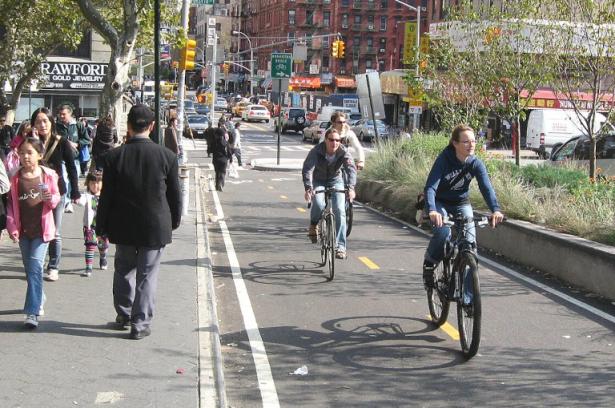The Hidden Potential of Bicycles

Bikeway in New York City, USA (2008),This photo was taken by participant/team Jim Henderson as part of the Commons:Wikis Take Manhattan project on October 4, 2008.
A Better World is Possible
The following column, “The Hidden Potential of Bicycles” by Brian Kaller, appeared in Portside on April 2 and in Kaller’s blog, Restoring Mayberry on March 29, 2024.
The bicycle remains the most efficient method of using our bodies, allowing us to attain higher machine speeds for longer than we would on muscle power alone – and without using any more fuel or causing any more weather to go haywire.
In perhaps one of the great ironies of human civilisation, mechanical devices to truly magnify human power came along as soon as we didn’t need them. Pedal-powered devices like bicycles only appeared after coal had already begun to transform the landscape, however – mass production was necessary for the standardised metal parts — and around the same time that gasoline was first being introduced as a fuel for automobiles.
We tend to forget, then, three important things about the bicycle. First, it remains the most efficient method of using our bodies, allowing us to attain higher machine speeds for longer than we would on muscle power alone – and without using any more fuel or causing any more weather to go haywire.
The average modern person, by one calculation, spends more than 1,600 hours a year to pay for their cars, their insurance, fuel and repairs. We go to jobs partly to pay for the cars, and we need the cars mostly to get to jobs. We spend four of our sixteen waking hours on the road or gathering the resources for the car. Since the average modern American, by one estimate, travels 7,500 miles a year, and put in 1,600 hours a year to do that, they are travelling five miles per hour. Before people had cars, however, people managed to do the same – by walking.
By contrast, a person on a bicycle can go three or four times faster than a pedestrian, but uses five times less energy in the process. He carries one gram of his weight over a kilometer of flat road at an expense of only 0.15 calories. The bicycle is the perfect transducer to match man’s metabolic energy to the impedance of locomotion. Equipped with this tool, a person outstrips the efficiency of not only all machines but all other animals as well.
Bicycles have been used for so long as children’s toys and exercise equipment that we forget what useful technology they represent. They multiply our bodies’ speed and efficiency many times over, allowing us to travel miles without strain. Their widespread adoption in the late 19th century created a ripple of under-appreciated effects in society; for example, they allowed women to commute to jobs away from home and paved the way for the universal sufferage movement.
Second, bicycles have seen many improvements in the last hundred years, most of which have escaped the notice of anyone but enthusiasts. Many of the bicycles we use today function mainly as toys, and racing bikes are built for speed; sturdier bicycles – often going under the name of “military bicycles” can still be ordered.
Most importantly, though, bicycles are only one of many possible pedal-powered machines that were not used for transportation. Beginning in the 19th century, factories began to make and stores to market treadles for manufacturing everything from cigars to brooms to hats. Farms used foot-powered harvesters, tractors, threshers, milking machines and vegetable bundlers, and machinists used pedal-powered drills.
“…no matter how simple it seems to us today, pedal power could not have appeared earlier in history,” wrote Kris DeDecker in LowTech Magazine. “Pedals and cranks are products of the industrial revolution, made possible by the combination of cheap steel (itself a product of fossil fuels) and mass production techniques, resulting in strong yet compact sprockets, chains, ball bearings and other metal parts.”
Today, we have built a world that runs on fossil fuels, which won’t last forever; eventually many of us will not be able to depend on familiar machines like cars and electronics – – either because we won’t be able to afford them, or to afford continually fixing them, or because fuel prices will be out of reach. One way or another, we will have to go back to muscle power, and the best way to do that is to revive the lost technologies of pedal-powered tools. The irony, though, is that we need to build them while we still have fossil fuels.
Perhaps more people around here will take to bicycles again, as I will now that there is enough light to get to the bus and back. Older people here remember when the bicycle was the most popular method for getting from one village to another, and the roads were safer then with so few cars. It’s possible that the schoolchildren of today will see those days again.
A Better World Is Possible is an occasional feature of the Amherst Indy that offers snapshots of creative undertakings, community experiments, innovative municipal projects, and excursions of the imagination that suggest possible interventions for the sundry challenges we face in our communities and as a species. This feature complements our occasional column by Boone Shear, who writes Becoming Human.
Have you seen creative approaches to community problems or examples of things that other communities do to make life better for their residents that you think we should be talking about? Send your observations/suggestions to amherstindy@gmail.com. See previous posts here.

Thanks for sharing this thought-provoking piece in The Indy.
Yes! And the electric assist bikes make it a no-brainer. They are all over the place in SF and with those the hills are no problem. Dedicated bike lanes should be as important as roads.